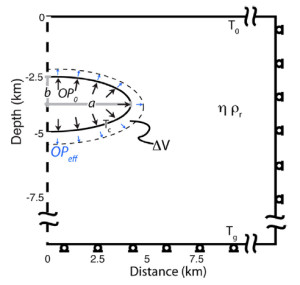 As molten rock ascends toward the surface of a planet it often stalls for a time, forming a shallow magma reservoir if the conditions are correct. When pressurized to the point of rupture, such reservoirs act to redirect magma laterally within the subsurface or can send magma on a path toward the surface again. Understanding the conditions that drive magma reservoir failure, and predicting the characteristic pathways followed by the magma that escapes, benefits from data gathered in the field, in the lab, and via analogue and numerical models. The latter have provided important insights in the last few decades, and they have also highlighted many areas where greater research is needed. For instance, how strong is the rock surrounding a reservoir, and what conditions exist there when a large (perhaps short-lived) magma body is present? Understanding these conditions is critical if we are to understand how much pressurization is required to initiate rupture — which in turn can help us understand when, and under what conditions, a given magma system might become hazardous to nearby populations.
As molten rock ascends toward the surface of a planet it often stalls for a time, forming a shallow magma reservoir if the conditions are correct. When pressurized to the point of rupture, such reservoirs act to redirect magma laterally within the subsurface or can send magma on a path toward the surface again. Understanding the conditions that drive magma reservoir failure, and predicting the characteristic pathways followed by the magma that escapes, benefits from data gathered in the field, in the lab, and via analogue and numerical models. The latter have provided important insights in the last few decades, and they have also highlighted many areas where greater research is needed. For instance, how strong is the rock surrounding a reservoir, and what conditions exist there when a large (perhaps short-lived) magma body is present? Understanding these conditions is critical if we are to understand how much pressurization is required to initiate rupture — which in turn can help us understand when, and under what conditions, a given magma system might become hazardous to nearby populations.
In a paper recently published in the journal Earth and Planetary Science Letters, Dr. Patricia Gregg, Dr. Shan de Silva (colleagues from Oregon State University) and I have used temperature-dependent numerical models to explore how an adaptive reservoir boundary — which in essence takes into account how pressurization of the magma system leads to displacement of the reservoir walls and hence a decrease in magma pressure — creates a feedback loop that helps limit the total pressure that can be achieved. When applied to the recent inflation event at Santorini, this new model approach helps constrains the reservoir size and, intriguingly, demonstrates why external triggering mechanisms may be needed before the reservoir can fail.